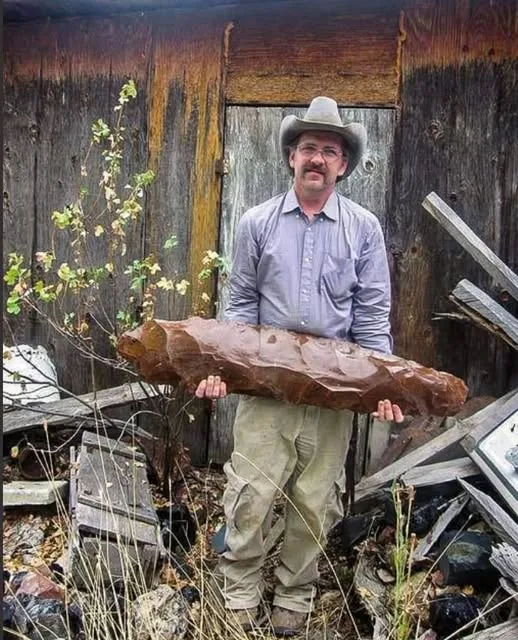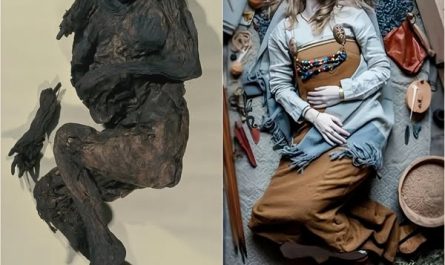Here in Phnom Penh, far from the vast freshwater expanse of North America’s Great Lakes, the whispers of ancient mysteries and remarkable craftsmanship still resonate. Today, let’s turn our attention to a discovery that has sparked considerable debate and awe, pitting the incredible skill of ancient hands against the masterful artistry of modern creators: a colossal stone object found along the shores of Lake Erie, Ohio.
Take a look at this truly impressive find:

The image presents a man, dwarfed by the sheer scale of the object he holds with both hands. It’s a striking piece, a massive, reddish-brown form that immediately brings to mind a giant spearhead, dagger, or perhaps even a ceremonial blade. Its surface shows the distinctive flaking patterns characteristic of flintknapping, the ancient art of shaping stone by carefully striking away flakes. The material itself, with its deep color and subtle sheen, suggests it could be high-quality flint or volcanic obsidian.
What truly sets this object apart, beyond its imposing size, is its remarkable craftsmanship. Even in a photograph, you can discern clean, purposeful edges, a meticulously shaped point, and an impressive sense of symmetry. It’s not just big; it’s beautifully made.
This combination of colossal scale and exquisite artistry has ignited a fascinating debate among archaeologists, collectors, and enthusiasts alike: Is this an authentic prehistoric artifact, or is it a dazzling modern reproduction?
The Case for Ancient Origin:
If this truly is a prehistoric artifact, its discovery along Lake Erie’s shores would be nothing short of monumental. For millennia, the lands surrounding the Great Lakes were home to various ingenious Native American cultures. Such a large and finely crafted piece could suggest several possibilities:
- Ceremonial Significance: Its immense size makes it impractical for everyday hunting or combat. This often points to a ceremonial purpose, perhaps used in rituals, as a symbolic offering, or as a grave good for a high-status individual. Such objects were often imbued with deep spiritual meaning.
- A Master Artisan’s Work: Regardless of its function, if ancient, it would represent the pinnacle of flintknapping skill from its era. Crafting a piece of this magnitude without modern tools would have required extraordinary knowledge of stone properties, immense patience, and unparalleled talent.
The Case for Modern Reproduction:
However, we live in an age where the ancient art of flintknapping has seen a powerful resurgence. There are incredibly talented modern flintknappers who dedicate themselves to perfecting this ancient craft, often capable of replicating or even surpassing the work of their ancestors.
- Unparalleled Skill: A modern knapper with access to large, high-quality raw materials and contemporary knowledge of the craft could certainly create such a piece.
- Lack of Context: Without proper archaeological excavation and contextual findings (like other associated artifacts, stratigraphic layers, or clear signs of ancient use/deposition), it’s incredibly difficult to definitively prove an ancient origin. A “surface find” (simply picking it up from the shore) always raises questions about its history since it was last handled.
The Ongoing Mystery:
Ultimately, as the original text wisely points out, pinning down the object’s true origin is tough without formal analysis or contextual excavation. Scientific dating methods could analyze any organic residues or the surface characteristics of the stone itself. A detailed examination by expert lithic analysts could reveal specific flaking patterns or wear traces consistent with ancient tools.
This “giant blade of Lake Erie” serves as a powerful reminder of the enduring allure of history and the incredible skill of human hands, whether ancient or modern. It invites us to ponder the countless stories hidden beneath our feet and the potential for extraordinary discoveries just waiting to be unearthed.
Do you have any insights into this object’s age, cultural background, or the exact location it was found? The mystery continues, a captivating piece of the puzzle from across the globe.





